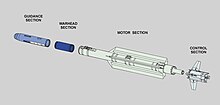IRIS-T
| IRIS-T | |
|---|---|
 1:1 model of the IRIS-T | |
| Type | Air-to-air missile |
| Place of origin | multinational with Germany as lead |
| Service history | |
| In service | December 2005 |
| Used by | See Users |
| Production history | |
| Manufacturer | Diehl BGT Defence |
| Unit cost | 400,000 € |
| Specifications | |
| Mass | 87.4 kg |
| Length | 2936 mm |
| Diameter | 127 mm |
| Wingspan | 447 mm |
| Warhead | HE/Fragmentation |
Detonation mechanism | Impact and active radar proximity fuze |
| Engine | Solid-fuel rocket |
Operational range | ~25 km |
| Flight altitude | Sea level to 20,000 m |
| Maximum speed | Mach 3 |
Guidance system | Infrared |
Launch platform | Users: |
The AIM-2000 IRIS-T (Infra Red Imaging System Tail/Thrust Vector-Controlled) is a German-led program to develop a short-range air-to-air missile to replace the venerable AIM-9 Sidewinder found in some of the NATO member countries. Any aircraft capable of carrying and firing Sidewinder is also capable of launching IRIS-T.
History


In the 1980s, NATO countries signed a Memorandum of Agreement that the United States would develop a medium-range air-to-air missile to replace the AIM-7 Sparrow, while Britain and Germany would develop a short-range air-to-air missile to replace the AIM-9 Sidewinder. The US design developed as the AIM-120 AMRAAM, while the UK-German design started as the AIM-132 ASRAAM.
ASRAAM started life in 1970 as a highly maneuverable design known as "Taildog", but development ended in 1974 with no production orders. This work was dusted off for the UK/German effort, with the Germans providing a new seeker, and the British providing most of the remaining components. In the intervening time, the need for high maneuverability was downgraded in favor of greater range.
As the AIM-120 worked at long ranges up to 20 miles, the very short-range Sidewinders and original Taildog left a wide performance gap that needed to be filled. The original design was re-worked to produce a much less maneuverable design, removing the thrust vectoring, and thereby greatly improving speed and range.
After German reunification in 1990, Germany found itself with large stockpiles of the Russian Vympel R-73 missiles (NATO reporting name: AA-11 Archer) carried by the MiG-29 Fulcrum and concluded that the AA-11's capabilities had been noticeably under-estimated. In particular, it was found to be both far more manoeuvrable, and far more capable in terms of seeker acquisition and tracking than the latest AIM-9 Sidewinder. These conclusions led Germany to question certain aspects of the design of ASRAAM related to the airframe which was a British responsibility. Of particular concern was the lack of thrust vectoring to aid manoeuvrability in close in air combat. When these concerns were raised, Germany and Britain could not come to an agreement about the design of ASRAAM, so in 1990 Germany withdrew from the ASRAAM project while Britain resolved to find another seeker and develop ASRAAM according to the original requirements.
In late 1990, the US partnership expressed similar concerns and embarked on an upgrade to the existing Sidewinder design to provide increased manoeuvrability and IRCCM (infrared counter counter measures) performance, i.e. measures to counter infrared countermeasures (IRCM). This program was designated AIM-9X.
Development partners
In 1995, Germany announced the IRIS-T development program, in collaboration with Greece, Italy, Norway, Sweden and Canada. Canada later dropped out.
Workshare arrangements for IRIS-T development are:
- Germany 46%
- Italy 19%
- Sweden 18%
- Greece 13%
- 4% split between Canada and Norway.
In 2003 Spain joined as a partner for procurement.
The Luftwaffe took first delivery of the missile on 5 December 2005.
Variants
IDAS
The IDAS variant is a navalized version of the missile, is also being developed for the new Type 212 submarine of the German Navy. IDAS is supposed to engage air threats, small or medium surface vessels or near land targets.
-
Model of IDAS
IRIS-T SL
Within the MEADS program, the Luftwaffe plans to integrate a land-launched radar-guided version of the missile, called IRIS-T SL.
-
IRIS-T SL missile
-
IRIS-T SL launch system
Combat performance
High ECM-Resistance, target discrimination and flare suppression and extreme close-in fight capability (60 g, 60°/s) and 5 to 8 times longer head-on firing range than the AIM-9L Sidewinder. Even targets behind the launching aircraft can be destroyed successfully by IRIS-T.
Users
 Germany
Germany- 1,250
 Spain
Spain- 770
 Greece
Greece- 350
 Austria
Austria- 25
 Sweden
Sweden Norway
Norway- 150
 Italy
Italy- 450
 Belgium
Belgium- 500
 Netherlands
Netherlands- 500
 Saudi Arabia
Saudi Arabia- Undisclosed number to be delivered
 South Africa
South Africa- 10 (only 10 delivered out of an original order of 30)



